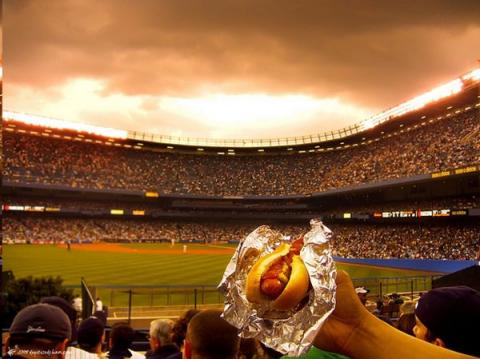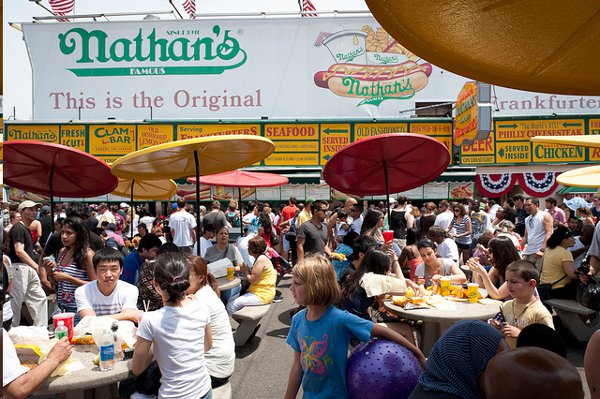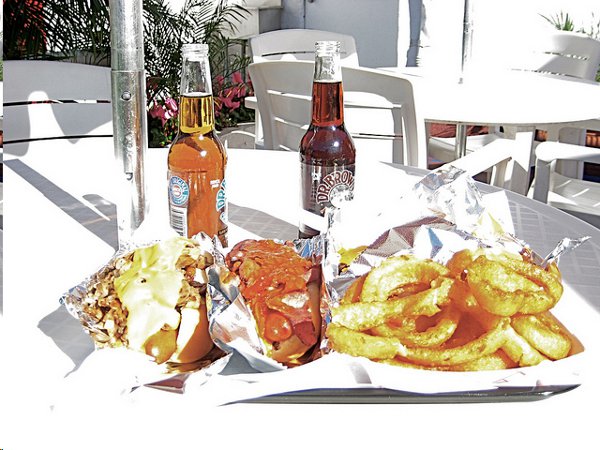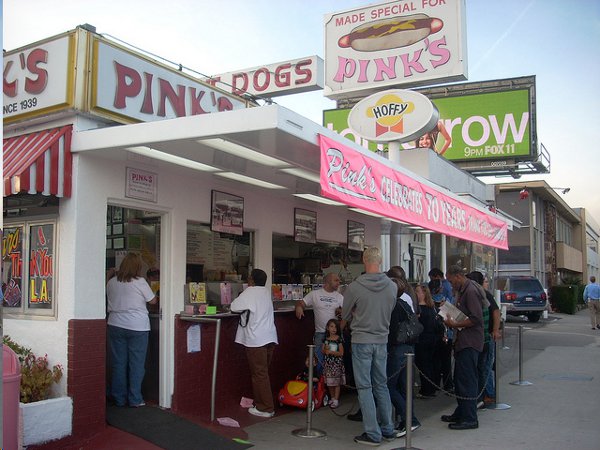America in a Bun: A History of Hot Dogs

Yes, America is a land of many cultures and a colorful journey of foods to explore. But what has remained one of the top icons of our country begs the question, ‘What am I eating?’
Despite health concerns, the hot dog is still a widely consumed national favorite, and July is National Hot Dog Month. The National Hot Dog and Sausage Council predicts Americans will have eaten more than 7 billion hot dogs between Memorial Day and Labor Day, with 155 million eaten during July 4 weekend.
So what’s in it? By U.S. law, a hot dog can contain up to 3.5 percent non-meat ingredients, usually milk or a soy product. Most popular brands use cellulose casings, which are removed before the product is packaged. Some use natural casings, which stay on the hot dog and provide that delightful “snap” when you bite into the hot dog.
In 2012, Americans spent $1.7 billion on hot dogs in supermarkets. But whether they come from a street peddler or at a ballgame, Americans have had a longstanding devotion to their hot dogs.
Who Let the Dogs Out?
There is much debate about the origin of this processed delight.
Hot dogs exploded in Chicago in 1893 at the Columbian Exposition, where visitors were attracted to its simplicity and convenience. It had existed long before in Germany, with the city of Frankfurt receiving the credit, amidst evidence that a butcher in Coburg invented it, then promoted it in Frankfurt. Austria also claims it was the first to have “wieners.” Even further back, Homer mentions sausages as a favorite of the ancient Greeks in The Odyssey. Frankfurt celebrated the 500th anniversary of frankfurters in 1987.

The confection was named “hot dog” by Thomas Francis Xavier Morris, or “Hot Dog Morris,” in Paterson, New Jersey in 1892, according to an NPR report. Born in Saint Thomas in the West Indies, he was a traveling “wild man” in a German circus and had been a chef both in New York and Europe before he began peddling frankfurters in Paterson, New Jersey. He also made a popular pepper sauce.
St. Louis, Missouri also holds an important role in hot dog history. The bun was most likely introduced in 1904 during the Louisiana Purchase Exposition (a.k.a. St. Louis World’s Fair) by Anton Feuchtwanger, a Bavarian concession worker. Apparently he ran out of gloves for patrons to use to hold their hot sausages, and his brother-in-law, a baker, concocted a long bun to fit the dogs. The hot dog was popularized at the event, and in 1893, it became the official food of baseball, started by the owner of the St. Louis Browns, Chris Von der Ahe.
Has the hot dog remained as popular as it once was? With more people than ever deeming themselves “foodies,” has the hot dog held its place as a necessity? Do we eat it because we know it, or because it actually tastes good?

Modern Dogs
At Hot Doug’s in Chicago, the lines outside tell you that these guys know a thing or two about hot dogs. Located in Avondale, “the Sausage Superstore and Encased Meat Emporium” often has dog lovers waiting patiently for a taste of Doug Sohn’s gourmet sausages.
On his Chicago episode of No Reservations, Anthony Bourdain visited to try what he deemed “local mutant forms of hot dogs.” In other words, Hot Doug’s features a rotating menu of various game sausages. Along with local fans of both their Chicago-style dog and fancy sausages, Hot Doug’s was also listed by Bon Appetit Magazine as one of the 50 best restaurants on the planet, probably due to the Foie Gras hot dog: duck sausage, topped with truffle mustard and foie gras. Don’t forget the duck fat fries, “decadent enough to make Elvis blush like a schoolgirl,” according to Bourdain.
Down some dank New York City stairs, Crif Dogs on St. Marks Place has dogs dressed up all kinds of fancy ways -- fancy or sloppy, depending how you look at it. The Crif Dog is a deep-fried dog made of beef and pork (if you want a grilled all-beef dog, order the New Yorker), and topping options are a lot to consider. The popular Tsunami dog has pineapple, bacon, teriyaki and green onions. Vegetarian dogs are on hand, too.
Still hungry? Take a walk over to the Lower East Side for Colombian style hot dogs at newcomer Los Perros Locos, or “crazy dogs.” You can choose from all-beef, chorizo, or vegetarian hot dogs. Toppings include chimichurri, apple chipotle slaw, or crushed Fritos.

Don’t forget the vegans. Vegans can get in on the hot dog fun at places like Brooklyn’s Foodswings, where they serve soy dogs and awesome shakes, or L.A.’s Federal Bar for a meatless dog made with lentils, brown rice, arugula and chipotle vegenaise.
But for most diehard fans, the hot dog is a simple reminder of childhood, perfectly dressed with brown mustard on a soft, fresh white bun.
Hot Dog Guide
Chicago: Steamed all-beef, natural-casing, mostly made by Vienna Beef or Red Hot Chicago. Topped with mustard, relish, chopped onions, tomato wedges, a pickle spear, pickled peppers, and celery salt, usually served on a poppyseed bun.
New York City: All-beef, natural-casing dogs, made by Sabrett’s parent company, Marathon Enterprises, in East Rutherford, New Jersey. Sold from a water bath in a Sabrett’s street cart on the corner, or from places like Papaya King, sure to give you that tasty “snap” when you bite it, or Katz’s, a meaty delight -- and no waiting in line. Don’t forget Nathan’s Famous in Coney Island, which reopened on Surf Avenue in May after damage from Hurricane Sandy. New York City ranks #2 for most hot dogs by volume.
Boston: Steamed dogs, a.k.a. “Fenway Franks,” popular with Red Sox fans. Check out Boston Super Dog for a large all-beef dog.
Los Angeles: Bacon-wrapped dogs and chili dogs are popular here. A favorite is the “Danger dog,” a.k.a. “Tijuana bacon dog,” bacon-wrapped, fried in oil and topped with grilled onions and chili. L.A. also has the New York-famous Papaya King, which doubles as a chic secret entrance to a music venue. Then, of course, there’s the Dodger dog, a 10-inch frank served steamed or grilled. Los Angeles consumes 95 million hot dogs, the most by volume of any city. And if you’re hankering for a ‘dog in L.A., a stop by the legendary Pink’s hotdog stand is a must.
Author Bio:
Beth Kaiserman is a contributor at Highbrow Magazine.
Photos: Rian Castillo; Precipeses; Arsenio Santos; LA Wad (Flickr, Creative Commons).





























































































































































































































































































































